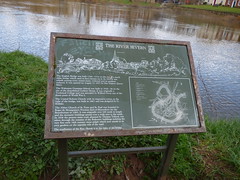English Bridge
Commemorated on 1 plaque
The River Severn The English Bridge was built 1768-1774 on the site of a much older bridge which used to have houses on it. In 1925 it was rebuilt reusing every sound stone, widened and its gradient reduced. It was opened on August 13 1927 by Her Majesty Queen Mary. The Wakeman Grammar School was built in 1936-38 on the site of the demolished Carlines House. It was originally a Technical College and was attended by Wiflred Owen one of the finest poets of World War I. The United Reform Church with its impressive tower, to the right of the bridge, was built in 1863 and was designed by G. Bidlake. The Abbey Church of St. Peter and St. Paul was founded by Roger de Montgomery Norman Earl of Shrewsbury for the Benedictines in 1083. It was originally over 100 yards in length and the monastic buildings spread over a wide area to the south. In 1836 the present main road, planned by Thomas Telford, was taken through the remains of the Refectory buildings isolating the very fine early 14th century stone pulpit which now stands in its own gardens on the opposite side of the road. The confluence of the Rea-Brook is to the right of the bridge.
English Bridge - Marine Terrace, Shrewsbury, United Kingdom where it built (1768-1774) and rebuilt (1925-1927)

